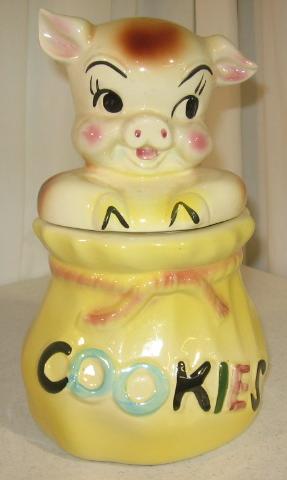Cookie jar
Cookie Jar[edit | edit source]
A cookie jar is a container typically used to store cookies and other small baked goods. Cookie jars are often made of ceramic or glass and are designed to keep cookies fresh while also serving as a decorative item in the kitchen.
History[edit | edit source]
The concept of the cookie jar originated in the United States during the early 20th century. Initially, these jars were simple glass containers with metal lids. As the popularity of cookies grew, so did the demand for more decorative and themed cookie jars. By the 1930s, ceramic cookie jars became popular, often featuring whimsical designs and characters.
Design and Materials[edit | edit source]
Cookie jars come in a variety of shapes, sizes, and materials. The most common materials used are ceramic, glass, and metal. Ceramic cookie jars are often hand-painted and glazed, providing a wide range of artistic designs. Glass jars are typically clear, allowing the contents to be visible, while metal jars may have a more industrial or vintage look.
Decorative Themes[edit | edit source]
Many cookie jars are designed with specific themes in mind, such as animals, holiday motifs, or popular cultural icons. These themed jars are often collected as decorative items and can become valuable collectibles over time.
Functionality[edit | edit source]
The primary function of a cookie jar is to keep cookies fresh by protecting them from air and moisture. A well-sealed jar can help maintain the texture and flavor of cookies for a longer period. Some cookie jars are designed with airtight seals to enhance their functionality.
Collectibility[edit | edit source]
Cookie jars have become popular collectibles, with some vintage jars fetching high prices at auctions. Collectors often seek out jars from specific manufacturers or those featuring unique designs. The collectibility of a cookie jar can depend on factors such as age, rarity, condition, and the popularity of the design.
Cultural Significance[edit | edit source]
In addition to their practical use, cookie jars hold a place in popular culture. They are often associated with childhood memories and the comfort of home-baked goods. The phrase "caught with your hand in the cookie jar" is a common idiom used to describe someone caught in the act of doing something sneaky or wrong.
Related Pages[edit | edit source]
Search WikiMD
Ad.Tired of being Overweight? Try W8MD's physician weight loss program.
Semaglutide (Ozempic / Wegovy and Tirzepatide (Mounjaro / Zepbound) available.
Advertise on WikiMD
|
WikiMD's Wellness Encyclopedia |
| Let Food Be Thy Medicine Medicine Thy Food - Hippocrates |
Translate this page: - East Asian
中文,
日本,
한국어,
South Asian
हिन्दी,
தமிழ்,
తెలుగు,
Urdu,
ಕನ್ನಡ,
Southeast Asian
Indonesian,
Vietnamese,
Thai,
မြန်မာဘာသာ,
বাংলা
European
español,
Deutsch,
français,
Greek,
português do Brasil,
polski,
română,
русский,
Nederlands,
norsk,
svenska,
suomi,
Italian
Middle Eastern & African
عربى,
Turkish,
Persian,
Hebrew,
Afrikaans,
isiZulu,
Kiswahili,
Other
Bulgarian,
Hungarian,
Czech,
Swedish,
മലയാളം,
मराठी,
ਪੰਜਾਬੀ,
ગુજરાતી,
Portuguese,
Ukrainian
Medical Disclaimer: WikiMD is not a substitute for professional medical advice. The information on WikiMD is provided as an information resource only, may be incorrect, outdated or misleading, and is not to be used or relied on for any diagnostic or treatment purposes. Please consult your health care provider before making any healthcare decisions or for guidance about a specific medical condition. WikiMD expressly disclaims responsibility, and shall have no liability, for any damages, loss, injury, or liability whatsoever suffered as a result of your reliance on the information contained in this site. By visiting this site you agree to the foregoing terms and conditions, which may from time to time be changed or supplemented by WikiMD. If you do not agree to the foregoing terms and conditions, you should not enter or use this site. See full disclaimer.
Credits:Most images are courtesy of Wikimedia commons, and templates, categories Wikipedia, licensed under CC BY SA or similar.
Contributors: Prab R. Tumpati, MD

